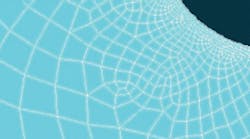|
Authored by
Key points
Resources Darrell Socie's fatiguecalculator.com has a stress-concentration-factor calculator. |
Take a look at any nearby shaft or axle and chances are you’ll see a shoulder fillet. Although it’s better than a sharp corner, the shoulder fillet still has a stress-concentration factor (Kt) designers must take into account. For years, designers relied on the formulas and graphs published in Peterson’s Stress Concentration Factors. But what if they weren’t as accurate as we thought?
Peterson’s solutions take the form of separate graphs for the three loading modes: bending, tension, and torsion. They have been published in mechanical-design textbooks and handbooks since their original appearance in 1953.
Peterson’s original equations for shoulder-fillet stress-concentration factors (SCFs) were actually rough engineering estimates. The analytical tools available when Peterson compiled his stress-concentration factors forced him to base his calculations for shoulder fillets on solutions for similar geometries, instead of directly computing the stress state.
Others had found formulas for the stress concentrations in hemispherical notches (or grooves, g) in two-dimensional plates, Kt,g,2D, as well as for fillets (f) in two-dimensional plates, Kt,f,2D. The hemispherical-notch solution had also been expanded to three dimensions to yield a SCF for circumferential grooves in round bars, Kt,g,3D. But the flat-plate fillet solution had not been translated into a 3D round shaft to get Kt,f,3D.
Peterson combined the three existing solutions to estimate the unknown Kt values for a filleted bar in three dimensions.
His estimate relied on the ratio:
where each Kt term stands in for its corresponding equation. The result is cumbersome to calculate, so Peterson generated a series of curves showing Kt as a function of fillet radius, r, over the smaller shaft diameter, d. Each curve represents a different ratio of the larger shaft diameter, D, to d. The solution is only applicable over limited ranges of r/d. Peterson developed a separate set of curves for each loading scenario: bending, tension, and torsion.
FEA fidelity
Modern analytical techniques can provide a more accurate, easier-to-handle solution. In fact, the 2007 edition of Peterson’s Stress Concentration Factors cites 1996 work, also from the University of Tulsa, that used finite-element analysis (FEA) to overcome many of the inaccuracies of the previous method.
With the advent of FEA, designers could use numerical equations to calculate SCFs instead of relying on printed curves and tables. They still needed a separate design equation for each loading mode, however. Researchers strove to develop a simpler design equation that would cover all loading regimes. With advances in computing speed and power, they were able to mesh the filleted shaft model more finely and cover more combinations of r, d, and D.
The fine mesh ensured the FEA would converge. It also produced a more-reliable location for the maximum stress in the fillet.
The analysis returned the maximum principal stress at each node as a result of axial loading, F, bending moment, M, and applied torsion, T. For the bending and tension cases, maximum principal stress in the axial direction was denoted σ1, and the stress in the circumferential direction was σ2. Equivalent stress σ e was computed by:
The SCFs, Kt, in terms of the maximum principal stress can be calculated by:
where Snom = nominal engineering stress on the system.
In bending this is given as:
In tension use:
Designers may also wish to compute the SCF in terms of von Mises equivalent stress, Kq, since fillet stresses are multiaxial in nature. To do so, replace σ1 in the above equation with σeq.
In the torsional loading case, the analysis returned τ max. The resulting Kt is given by:
where:
The von Mises SCF in torsion is related to the maximum principal SCF in torsion by:
The resulting maximum SCFs reveal that Peterson’s original equations can underestimate the stress concentration at a shoulder fillet by as much as 24%.
The FEA-derived solutions can be represented by graphs like Peterson’s or distilled into a single design equation:
The cx in the equation are numerical constants chosen based on the loading regime to yield either Kt or Kq. The constants are listed in the accompanying tables.
Knowing the location of the maximum stress is just as critical as knowing its value. The information can be invaluable for experimental stress analysis or failure analysis. The angle from the smaller portion of the shaft up the fillet to the point of maximum stress is denoted as Φ :
Replace the ax terms with the numerical constants listed in the table below for bending, tension, and torsion loading.
Although the equations and graphs depicted here focus on loading in bending, tension, or torsion alone, combined-loading cases are the realworld norm. To arrive at the maximum equivalent stress when bending or tension is accompanied by torsion, design engineers can figure circumferential stress, σ2 using the principle and equivalent stresses from the bending or tension loading, σ 1 and σ eq .
Use the earlier equation for σ eq to compute the maximum equivalent stress of the system from σ 1 and the new σ2.
